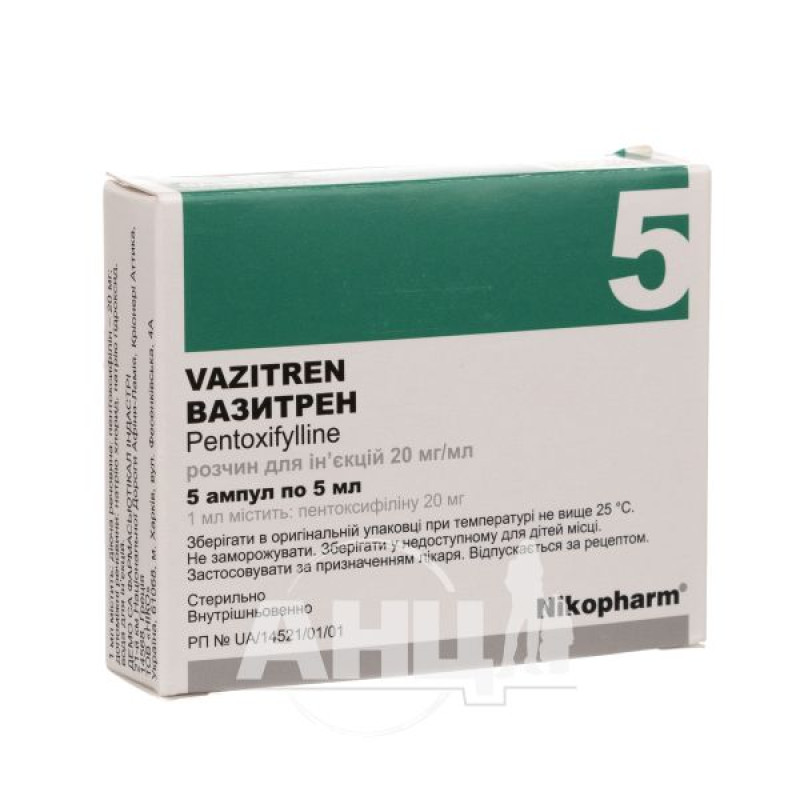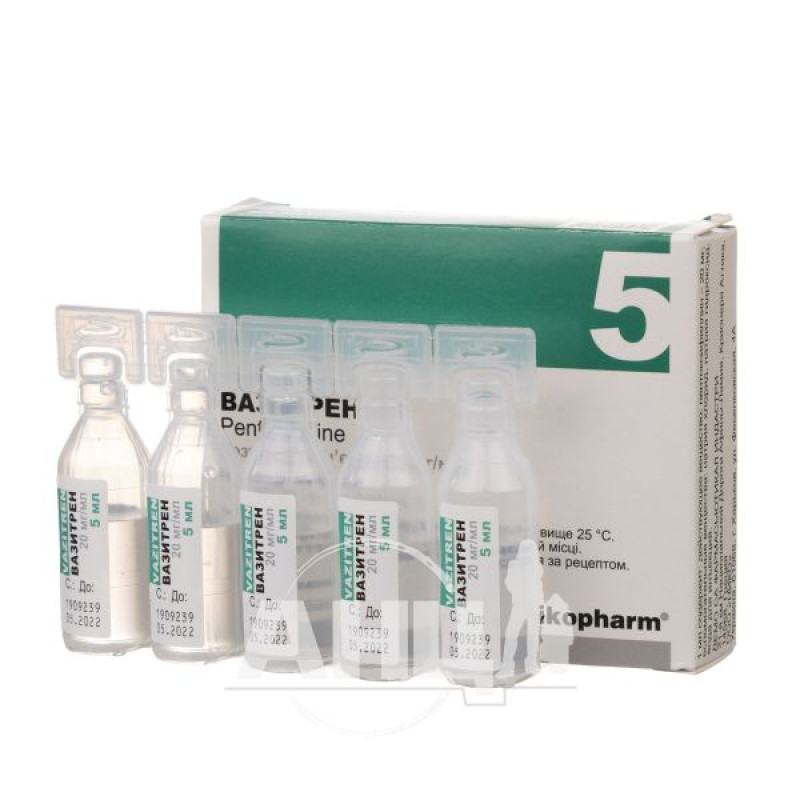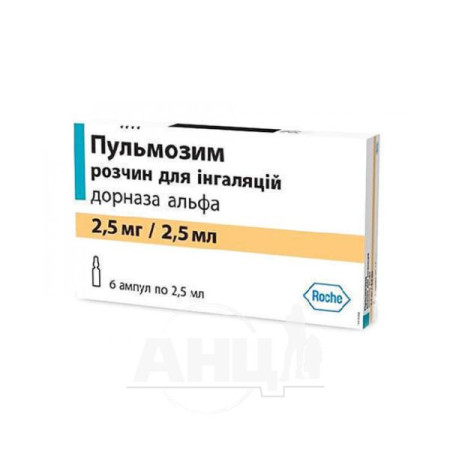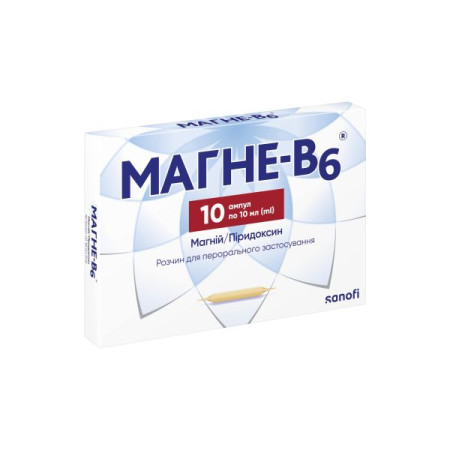Vasitren (Pentoxifylline-N) solution for injection 20 mg/ml ampoule 5 ml No. 5

Instructions for Vasitren (Pentoxifylline-N) solution for injection 20 mg/ml ampoule 5 ml No. 5
Composition
active ingredient: pentoxifylline;
1 ml of solution contains 20 mg of pentoxifylline;
Excipients: sodium chloride, sodium hydroxide, water for injections.
Dosage form
Solution for injection.
Main physicochemical properties: colorless transparent solution.
Pharmacotherapeutic group
Peripheral vasodilators. ATX code C04A D03.
Pharmacological properties
Pharmacodynamics.
Pentoxifylline is a methylxanthine derivative. The mechanism of action of pentoxifylline is associated with the inhibition of phosphodiesterase and the accumulation of cAMP in vascular smooth muscle cells, blood cells, and other tissues and organs. Pentoxifylline inhibits platelet and erythrocyte aggregation, increases their flexibility, reduces the increased concentration of fibrinogen in blood plasma, and enhances fibrinolysis, which reduces blood viscosity and improves its rheological properties. In addition, pentoxifylline has a weak myotropic vasodilator effect, slightly reduces total peripheral vascular resistance, and has a positive ionotropic effect. As a result of the use of pentoxifylline, microcirculation and tissue oxygen supply improve, most of all in the extremities, central nervous system, and moderately in the kidneys. The drug slightly dilates coronary vessels.
Pharmacokinetics.
The main pharmacologically active metabolite ˗ 1-(5-hydroxyhexyl)-3,7-dimethylxanthine (metabolite I) is determined in blood plasma at a concentration exceeding the concentration of the unchanged substance by 2 times and is in a state of reverse biochemical equilibrium with it. In this regard, pentoxifylline and its metabolite should be considered as an active whole. The half-life of pentoxifylline is 1.6 hours.
Pentoxifylline is completely metabolized, more than 90% is excreted by the kidneys in the form of unconjugated water-soluble polar metabolites. Less than 4% of the administered dose is excreted in the feces. In patients with severe renal impairment, excretion of metabolites is slowed down. In patients with hepatic impairment, an increase in the half-life of pentoxifylline has been noted.
Indication
Atherosclerotic encephalopathy; ischemic cerebral stroke; dyscirculatory encephalopathy; peripheral circulatory disorders caused by atherosclerosis, diabetes mellitus (including diabetic angiopathy), inflammation; trophic disorders in tissues associated with venous damage or microcirculation disorders (postthrombophlebitic syndrome, trophic ulcers, gangrene, frostbite); obliterating endarteritis; angioneuropathy (Raynaud's disease); eye circulatory disorders (acute, subacute, chronic circulatory insufficiency in the retina and choroid of the eye); inner ear dysfunction of vascular genesis, accompanied by hearing loss.
Contraindication
Pentoxifylline is contraindicated in patients:
- with hypersensitivity to pentoxifylline, to other methylxanthines or to any of the excipients of the drug Vasitren;
- with massive bleeding (risk of increased bleeding);
- with extensive hemorrhage in the retina of the eye, with hemorrhage in the brain (risk of increased bleeding).
If retinal hemorrhage occurs during treatment with pentoxifylline, the drug should be discontinued immediately:
- in the acute period of myocardial infarction;
- with stomach ulcers and/or intestinal ulcers;
- with hemorrhagic diathesis.
Interaction with other medicinal products and other types of interactions
The blood sugar-lowering effect of insulin or oral antidiabetic agents may be potentiated. Therefore, patients receiving drug treatment for diabetes should be closely monitored.
There are known cases of increased anticoagulant activity in patients who were simultaneously treated with pentoxifylline and vitamin K antagonists. When prescribing or changing the dosage of pentoxifylline, it is recommended to monitor anticoagulant activity in this group of patients.
Pentoxifylline may enhance the hypotensive effect of antihypertensive agents and other drugs that can cause a decrease in blood pressure.
Concomitant use of pentoxifylline and theophylline may lead to increased blood levels of theophylline in some patients. Therefore, an increase in the frequency and severity of adverse reactions to theophylline is possible.
In some patients, concomitant use with ciprofloxacin may lead to an increase in the serum concentration of pentoxifylline. As a result, the frequency and severity of adverse reactions associated with the simultaneous use of the drugs may increase.
Potential additive effect with platelet aggregation inhibitors: Due to the increased risk of bleeding, concomitant use of platelet aggregation inhibitors (e.g. clopidogrel, eptifibatide, tirofiban, epoprostenol, iloprost, abciximab, anagrelide, NSAIDs other than selective COX-2 inhibitors, acetylsalicylates [ASA/LAS], ticlopidine, dipyridamole) with pentoxifylline should be done with caution.
Concomitant use with cimetidine may increase the concentration of pentoxifylline and metabolite I in blood plasma.
At the first signs of an anaphylactic/anaphylactoid reaction, the pentoxifylline infusion should be stopped immediately and medical attention should be sought.
When using pentoxifylline in patients with chronic heart failure, the phase of circulatory compensation should first be achieved.
In patients with diabetes and treated with insulin or oral hypoglycemic agents, the effect of these drugs on blood sugar levels may be increased when high doses of pentoxifylline are used (see section "Interaction with other medicinal products and other types of interactions"). In these cases, the dose of insulin or oral antidiabetic agents should be reduced and the patient should be especially carefully monitored.
Patients with systemic lupus erythematosus (SLE) or other connective tissue diseases should be prescribed pentoxifylline only after a thorough analysis of the possible risks and benefits.
Since there is a risk of developing aplastic anemia during treatment with pentoxifylline, regular complete blood counts are required.
In patients with renal insufficiency (creatinine clearance less than 30 ml/min) or severe liver dysfunction, the elimination of pentoxifylline may be delayed. Appropriate monitoring is required.
Particularly careful observation is necessary for patients:
- with severe cardiac arrhythmia;
- with arterial hypotension;
- with pronounced atherosclerosis of cerebral and coronary vessels, especially with concomitant arterial hypertension and heart rhythm disturbances (these patients may experience angina attacks, arrhythmias and arterial hypertension when taking the drug);
- with renal failure (creatinine clearance below 30 ml/min);
- with severe liver failure;
- with a high tendency to bleeding, due, for example, to treatment with anticoagulants or blood clotting disorders (for bleeding, see the section "Contraindications");
- who have recently undergone surgical treatment (increased risk of bleeding, which requires systematic monitoring of hemoglobin and hematocrit levels);
- for whom a decrease in blood pressure poses a high risk (for example, patients with severe ischemic heart disease or stenosis of the vessels supplying blood to the brain);
- who are simultaneously receiving treatment with pentoxifylline and vitamin K antagonists or platelet aggregation inhibitors (see section “Interaction with other medicinal products and other types of interactions”);
- who are simultaneously receiving treatment with pentoxifylline and antidiabetic agents (see section “Interaction with other medicinal products and other types of interactions”);
- who are simultaneously receiving treatment with pentoxifylline and ciprofloxacin (see section “Interaction with other medicinal products and other types of interactions”);
- who are simultaneously receiving treatment with pentoxifylline and theophylline (see section "Interaction with other medicinal products and other types of interactions").
Use during pregnancy or breastfeeding.
Pregnancy: Due to the lack of sufficient experience, pentoxifylline should not be prescribed during pregnancy.
Breastfeeding. Pentoxifylline passes into breast milk in small amounts. If treatment with pentoxifylline is prescribed, breastfeeding should be discontinued.
The ability to influence the reaction speed when driving vehicles or other mechanisms.
Does not affect.
Method of administration and doses
Intravenous infusions are the most effective and well-tolerated forms of parenteral administration of the drug. The dosage regimen is determined by the doctor and depends on the severity of circulatory disorders, body weight and tolerability of treatment. Infusion can be carried out only if the solution is clear.
The following treatment regimens are recommended for adults:
1. Intravenous infusion of 100-600 mg of pentoxifylline in 100-500 ml of Ringer's lactate solution, 0.9% sodium chloride solution or 5% glucose solution 1-2 times a day. The duration of intravenous drip infusion is 60-360 minutes, i.e. the administration of 100 mg of pentoxifylline should last at least 60 minutes. The infusion can be supplemented with oral administration of pentoxifylline (400 mg) with the calculation that the maximum daily dose (infusion and oral) is 1200 mg.
2. In case of severe condition of the patient (especially in case of constant pain, gangrene or trophic ulcers), it is possible to carry out an infusion of pentoxifylline within 24 hours. With this administration scheme, the dose is determined at the rate of 0.6 mg/kg/hour. The daily dose calculated in this way for a patient with a body weight of 70 kg is 1000 mg, for a patient with a body weight of 80 kg - 1150 mg. Regardless of the patient's body weight, the maximum daily dose is 1200 mg. The volume of the infusion solution is calculated individually, taking into account concomitant diseases and the patient's condition, and is on average 1-1.5 l per day.
3. In some cases, the drug is administered by intravenous injection of 5 ml (100 mg). The injection is performed slowly, over 5 minutes, with the patient in the supine position.
The duration of parenteral treatment is determined by the treating physician. After the patient's condition improves, it is recommended to continue treatment using the oral form of pentoxifylline.
Procedure for working with the ampoule:
2. Squeeze the ampoule with your hand (no drug should be released) and twist and separate the head with rotational movements.
3. Immediately connect the syringe to the ampoule through the hole formed.
4. Turn the ampoule over and slowly draw its contents into the syringe.
5. Put the needle on the syringe.
Children.
Do not apply.
Overdose
Symptoms: Initial symptoms of acute overdose with pentoxifylline are nausea, dizziness or decreased blood pressure. In addition, symptoms such as fever, agitation, hot flashes, tachycardia, loss of consciousness, areflexia, arrhythmia, tonic-clonic convulsions and coffee-ground vomitus as a sign of gastrointestinal bleeding may develop.
Treatment. In order to treat acute overdose and prevent complications, general and specific intensive medical observation and the implementation of therapeutic measures are necessary.
Side effects
Laboratory indicators: increased transaminase levels.
Cardiac: arrhythmia, tachycardia, angina pectoris, decreased blood pressure, increased blood pressure.
From the hematopoietic and lymphatic system: thrombocytopenia with thrombocytopenic purpura and aplastic anemia (partial or complete cessation of the formation of all blood cells, pancytopenia), which can be fatal, leukopenia/neutropenia.
Nervous system: dizziness, headache, aseptic meningitis, tremor, paresthesia, convulsions.
Gastrointestinal: gastrointestinal disorders, feeling of pressure in the stomach, flatulence, nausea, vomiting, diarrhea, constipation, hypersalivation.
Skin and subcutaneous tissue disorders: itching, skin redness and urticaria, toxic epidermal necrolysis (Lyell's syndrome), Stevens-Johnson syndrome, rash.
Vascular: hot flashes, bleeding, peripheral edema.
Immune system disorders: anaphylactic reactions, anaphylactoid reactions, angioedema, bronchospasm and anaphylactic shock.
Liver and biliary tract disorders: intrahepatic cholestasis.
Mental disorders: agitation and sleep disturbances, hallucinations.
From the organs of vision: visual impairment, conjunctivitis, retinal hemorrhages, retinal detachment.
General disorders: hypoglycemia, increased sweating, increased body temperature.
Expiration date
2.5 years.
Storage conditions
Store in the original packaging at a temperature not exceeding 25 ° C. Do not freeze. Keep out of the reach of children.
Incompatibility
The drug should not be mixed in the same container with other solutions, except for the solutions specified in the "Method of administration and dosage" section.
Packaging
5 ml in polyethylene ampoules No. 5.
Vacation category
According to the recipe.
Producer
DEMO SA PHARMACEUTICAL INDUSTRY.
LLC "NIKO".
Location of manufacturers and addresses of their place of business.
21st km of the Athens-Lamia National Road, Kryoneri Attica, 14568, Greece.
Tel.: +30 210 8161802
Email: info@demo.gr
Ukraine, 61068, Kharkiv, Fesenkivska St., 4A.
Tel.: +38 (095) 282-66-10
E-mail: office@nikopharm.com.ua
There are no reviews for this product.
There are no reviews for this product, be the first to leave your review.
No questions about this product, be the first and ask your question.
















